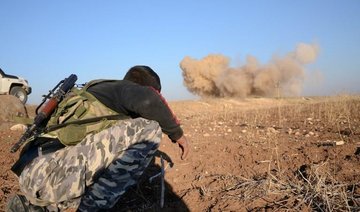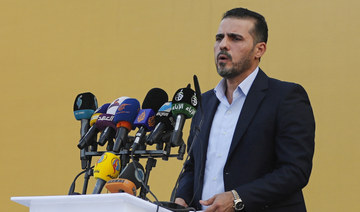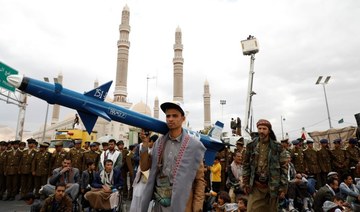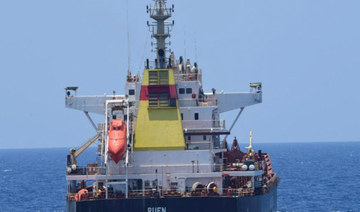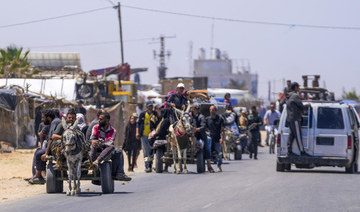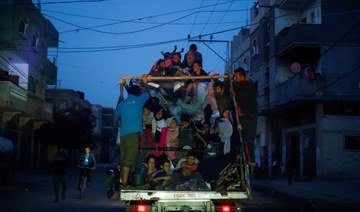RAQQA, Syria: Across the ruins of Raqqa, the streets are cloaked in grey, the color of bare cement and rubble left behind by the bombing campaign that finally drove out Daesh militants. Among the people of this Syrian city, the fear, anger and desperation are palpable.
Six months after Daesh’s ouster, residents feel they have been abandoned as the world moves on. They are trying to rebuild their lives, but they say they fear everyone around them: the Kurdish-led militia that administers the majority Arab city; the Syrian government, which has forces nearby; criminal gangs who kidnap or rob whoever shows signs of having money; and Daesh militants who may still be hiding among the people.
“Daesh is still among us,” said a businessman. To give an example, he said, a man lobbed a hand grenade at a recent funeral when mourners played music, something extremists view as sacrilegious.
The Associated Press spoke to over a dozen residents on a recent visit, most of who spoke of their woes on condition of anonymity because they feared for their safety. The businessman asked to be identified by the diminutive of his first name, Abdu.
After fleeing Raqqa during the coalition-led assault on the city last year, Abdu returned once the militants were driven out in October. He found his restaurant and his home next to it destroyed. He was angry, but practical. His life has been on hold for too long and he wanted to get on with his business. So he hired workers and started to rebuild.
But local gangs had eyed him. He was kidnapped and held for $10,000 ransom, until his tribe intervened and rescued him without paying, he said.
He, like many others, lamented the loss of security, which he said was one prize feature of living under Daesh. He faulted the Kurdish-led forces for hastily recruiting local Arabs to boost their ranks and appease the local Arab tribes.
“We end up with thieves or former Daesh in the force,” he said.
For three years, Raqqa was the de facto capital of the Daesh group’s “caliphate” stretching across much of Iraq and Syria. In the campaign of the US-led coalition and Iraqi and Syrian partners, the group has been uprooted from almost that entire territory.
UN officials say Raqqa has been left the most devastated city in all of Syria’s seven-year-old war, a conflict that has also seen Syrian government forces backed by Russian and Iranian forces battling rebels. All of Raqqa suffered intense airstrikes by the US-led coalition and the whole population of at least 350,000 had to flee. The infrastructure was destroyed, as were 65 percent of civilian homes, said Leila Mustafa, a member of the US-backed Raqqa Civil Council that now runs the city.
A prominent Arab tribesman escorted the AP to see a building he owned that was gutted by airstrikes. He angrily complained that coalition bombing was indiscriminate. Like many, he said there should be compensation but didn’t expect any would be given.
“I wish I even found the bone of an Daesh member in there! But nothing. No reason,” he said. “Now, who will pay for this?” He refused to give his name, fearing his criticism would undermine his chances of ever getting money to rebuild.
Nothing is unaffected by the bombardment. Mosques, schools, squares and buildings have all taken hits, some repeatedly. Trees on the street are burned. Insects and dust saturate the air.
The stench of death rises from crushed buildings and remains long after the bodies are removed. Civil workers say they have pulled nearly 500 bodies from under the rubble in the past three months, working with just one bulldozer.
Some streets have been cleared of wreckage, giving way to a scene even more haunting because of how organized it is. Scrap metal and debris are neatly stacked in heaps at the foot of destroyed buildings. Row after row of buildings reduced to concrete skeletons run like a pattern through the city. Large chunks of cement dangle from twisted rebar above sidewalks like cryptic decorations. At least 8,000 explosives riddle the city center.
Major overpasses have been hit, as well as bridges across the Euphrates River, which cuts through the city. Residents and their cars cross on small barges.
Yet the buzz of activity is startling. Nearly 100,000 residents have returned, according to UN accounts. Mustafa said it was likely much higher.
Women in colorful scarves punctuated the grey monotone in the markets. A market for scrap metal has sprung up at one end of the city. Meat grills lined some streets, and warehouses were full of soft drinks, water, grains and other stock. Bulldozers drilled into the wreckage of buildings.
Workers from nearby provinces have come looking for opportunities. The driver of a truck full of mattresses with job hunters sitting on top said they came from the northwestern city of Aleppo.
“They can’t do it all alone,” a construction worker from the neighboring province of Deir Ezzor said at the site of a destroyed bridge.
Those with money rebuild. Painters added some color to the facade of a former car dealership. Its owner, who asked only to be identified as Ismail, said Daesh had used its back rooms as a prison.
When he came back to Raqqa, he heard of masked gangsters who rob returnees. But it has not stopped him. He is turning his dealership into an Internet cafe, much needed in a city that has no phone lines and relies heavily on personal generators for electricity.
He said he paid $600 to clean the wreckage from his street. “I want to make it feel safe,” he said.
Mustafa, the council member, said most of the restoration work was self-financed, with some US money, though she would not say how much. On Thursday, with American officials attending, she inaugurated a new pre-fab bridge to connect the city to neighboring villages. One US official said installing the bridge cost $7,000.
The city is getting “very limited” support — “no match to the size of the needs,” she said. Infrastructure was totally destroyed, as were 65 percent of civilian buildings, and mines and rubble still need to be cleared, she said. She could not say the total cost for rebuilding since it is constantly being reevaluated.
Raqqa paid a “hefty price” for the war on terrorism, she said, but “international organizations and some countries didn’t live up to their responsibilities.”
US officials have led operations to clear land mines and restore basic services like water and electricity in the city. But those programs would likely have to be called off if President Donald Trump goes forward with plans to withdraw American troops within five or six months. In meeting with national security aides, he has railed against the trillions the US has spent in the Mideast, saying it brought no return.
Instead, Trump has asked Saudi Arabia to contribute $4 billion toward reconstruction and stabilization in Syria.
Despite the devastation, signs of Daesh remained around Raqqa.
The infamous Naim Square — Arabic for “Paradise” — where Daesh militants displayed hanged bodies or heads, was empty aside from a single chair in the street that marked a former checkpoint of the militants. On the other end were remains of a Daesh media center with broken chairs and a stand where the screen was once set to show Daesh videos to the public.
A juice shop and a supermarket were the only signs of life in the square, surrounded by destroyed buildings. Seals used by Daesh were still visible on the metal shutters of shops, numbering them for tax collection purposes.
Nahla Mustafa walked absent-mindedly nearby, pulling her seven-year old son Baseel behind.
Asked how she is, she immediately said, “Everything is lost,” and her eyes welled with tears. The war had impoverished her well-to-do family. Militants confiscated her husband’s clothing store. The three homes they owned were destroyed in coalition strikes and she had multiple miscarriages, which she blamed on fear from the bombing.
She now makes clothes for a living and asks around houses for odd jobs. Looking at her purse, she said, “I have 3,000 liras ($7) in here. What do I do with this?” Her husband works in a grocery store, earning the equivalent of $45 a month.
“I am tired and I am scared,” she said. “When will we be able to save to fix our homes — when (my husband) is 100?” Her son doesn’t go to school because she worries about land mines.
“What will become of his future? What is our fault in all of this?“
Syrians in Raqqa afraid, angry, frustrated as they rebuild
Syrians in Raqqa afraid, angry, frustrated as they rebuild
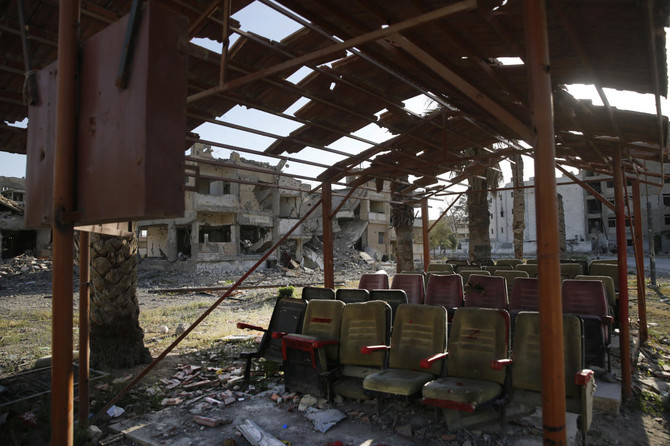
Hamas says Gaza ceasefire efforts are back at square one

- Israel has killed more than 34,700 Palestinians, according to Gaza’s Health Ministry
CAIRO: The Palestinian militant group Hamas said on Friday that efforts to find a Gaza Strip truce deal were back at square one after Israel effectively spurned a plan from international mediators, and the White House said it was trying to keep the sides engaged “if only virtually.”
Hamas said in a statement it would consult with other Palestinian factions on its strategy for talks to halt seven months of war triggered by its deadly Oct. 7 attack on Israel.
Hours earlier, the United Nations warned that aid for Gaza could grind to a halt in days after Israel seized control this week of the Rafah crossing between Gaza and Egypt, a vital route for supplies to the devastated Palestinian enclave.
Despite heavy US pressure, Israel has said it will proceed with an assault on the southern Gaza city of Rafah, where more than 1 million displaced people have sought refuge and Israeli forces say Hamas militants are dug in.
Israeli tanks captured the main road dividing the eastern and western sections of Rafah, effectively encircling the eastern part of the city in an assault that has caused Washington to hold up delivery of some military aid.
The White House said that it was watching “with concern,” but the Israeli operations appeared to be localized around the shuttered Rafah crossing and did not reflect a large-scale invasion.
“Once again, we urge the Israelis to open up that crossing to humanitarian assistance immediately,” said White House national security spokesman John Kirby.
Israel’s plan for an all-out assault on Rafah has ignited one of the biggest rifts in generations with its main ally. Washington held up a weapons shipment over fears of massive civilian casualties.
In a report to Congress, President Joe Biden’s administration on Friday said it was reasonable to assess that Israel had used US arms in instances “inconsistent” with international humanitarian law.
However, the administration said it still found credible and reliable Israel’s assurances that it will use US weapons in accordance with international humanitarian law.
Indirect diplomacy has failed to end a war that health authorities in Hamas-run Gaza say has killed almost 35,000 people since the Oct. 7 attack. Some 1,200 people were killed in Israel and 253 taken hostage on Oct. 7, according to Israeli tallies.
Ceasefire talks in Cairo broke up on Thursday with no agreement.
Hamas had said it agreed at the start of the week to a proposal by Qatari and Egyptian mediators that had previously been accepted by Israel. Israel said the Hamas proposal contained elements it cannot accept.
“Israel’s rejection of the mediators’ proposal through the amendments it made returned things to the first square,” Hamas said in Friday’s statement.
“In the light of (Israel Prime Minister Benjamin) Netanyahu’s behavior and rejection of the mediators’ document and the attack on Rafah and the occupation of the crossing, the leadership of the movement will hold consultations with the brotherly leaders of the Palestinian factions to review our negotiation strategy.”
“Hamas did not suspend nor withdraw from the negotiations; the occupation (Israelis) turned against the mediators’ proposal,” a senior Hamas official, Khalil Al-Hayya, said in comments to Al Araby TV published by Hamas.
Kirby said the end of the talks — which CIA Director William Burns was helping mediate — was “deeply regrettable,” but the US believed the differences were surmountable.
“We are working hard to keep both sides engaged in continuing the discussion, if only virtually,” he said.
EXPLOSIONS AND GUNFIRE
Residents described almost constant explosions and gunfire east and northeast of Rafah on Friday, with intense fighting between Israeli forces and militants from Hamas and Islamic Jihad.
Hamas said it ambushed Israeli tanks near a mosque in the east of the city, a sign the Israelis had penetrated several kilometers from the east to the outskirts of the built-up area.
Israel has ordered civilians out of the eastern part of Rafah, forcing tens of thousands of people to seek shelter outside the city, previously the last refuge of more than a million who fled other parts of the enclave during the war.
Israel says it cannot win the war without assaulting Rafah to root out thousands of Hamas fighters it believes are sheltering there. Hamas says it will fight to defend it.
Supplies were already running short and aid operations could halt within days as fuel and food stocks get used up, UN aid agencies said.
“For five days, no fuel and virtually no humanitarian aid entered the Gaza Strip, and we are scraping the bottom of the barrel,” said the UNICEF Senior Emergency Coordinator in the Gaza Strip, Hamish Young.
Aid agencies say the battle has threatened hundreds of thousands of displaced civilians.
“It is not safe, all of Rafah isn’t safe, as tank shells landed everywhere since yesterday,” Abu Hassan, 50, a resident of Tel Al-Sultan west of Rafah told Reuters via a chat app.
“I am trying to leave but I can’t afford 2,000 shekels ($540) to buy a tent for my family,” he said. “There is an increased movement of people out of Rafah even from the western areas, though they were not designated as red zones by the occupation.”
Israeli tanks have sealed off eastern Rafah from the south, capturing and shutting the only crossing between the enclave and Egypt. An advance on Friday to the Salahuddin road that bisects the Gaza Strip completed the encirclement of the “red zone” where they have ordered residents out.
The Israeli military said its forces in eastern Rafah had located several tunnel shafts, and troops backed by an air strike fought at close quarters with groups of Hamas fighters, killing several.
It said Israeli jets had hit several sites from which rockets and mortar bombs had been fired toward Israel.
The UN General Assembly overwhelmingly backed a Palestinian bid to become a full UN member by recognizing it as qualified to join and recommending the UN Security Council “reconsider the matter favorably.”
Iranians vote in parliamentary runoff election

- Politicians calling for change in the country’s government, known broadly as reformists, were generally barred from running in the election
TEHRAN: Iranians voted on Friday in a runoff election for the remaining seats in the country’s parliament after hard-line politicians dominated March balloting.
People in 22 constituencies across the country will elect 45 representatives from a pool of 90 candidates, 15 of whom are considered moderate.
In the capital, Tehran, 16 representatives will be chosen from 32 candidates, all hard-liners.
Final results are expected on Monday, though counts in smaller constituencies are likely before that.
Iran’s parliament plays a secondary role in governing the country.
Supreme Leader Ali Khamenei has the final say in all important state matters.
State TV showed Khamenei voting on Friday immediately after the polls opened.
He urged people to vote and said the runoff election was as important as the main one.
In the March election, hard-liners won 200 out of 245 seats, with more moderate candidates taking the other 45. A total of 25 million ballots were cast, for a turnout of just under 41 percent.
The previous lowest turnout was 42 percent in the 2020 parliamentary election.
Politicians calling for change in the country’s government, known broadly as reformists, were generally barred from running in the election.
Those calling for radical reforms or for abandoning Iran’s theocratic system were also banned or did not bother to register as candidates.
Suspected pirate attack in Gulf of Aden raises concerns about growing Somali piracy

- Somali piracy in the region at the time cost the world’s economy some $7 billion — with $160 million paid out in ransoms, according to the Oceans Beyond Piracy monitoring group
DUBAI: A European naval force detained six suspected pirates on Friday after they opened fire on an oil tanker traveling through the Gulf of Aden, officials said, likely part of a growing number of piracy attacks emanating from Somalia.
The attack on the Marshall Islands-flagged Chrystal Arctic comes as Houthis have also been attacking ships traveling through the crucial waterway, the Red Sea, and the Bab Al-Mandeb Strait connecting them.
The assaults have slowed commercial traffic through the key maritime route onward to the Suez Canal and the Mediterranean Sea.
The pirates shot at the tanker from a small ship “carrying weapons and ladders,” according to the British military’s UK Maritime Trade Operations Center, which oversees Mideast shipping routes.
The pirates opened fire first at the Chrystal Arctic, whose armed onboard security team returned fire at them, the UKMTO said.
BACKGROUND
Maritime sources say pirates may be encouraged by a relaxation of security or may be taking advantage of the chaos caused by attacks on shipping by the Houthis.
The pirates then abandoned their attempt to take the tanker, which continued on its way with all its crew safe, the UKMTO said.
Hours later, the EU naval force in the region known as Operation Atalanta said a frigate operating in the region detained six suspected pirates.
The frigate seized the pirates, given “the unsafe condition of their skiff” and said that some had “injuries of varied severity.”
It was not immediately clear if those injured suffered gunshot wounds from the exchange of fire with the Chrystal Arctic.
The EU force declined to elaborate “due to the security of the operations.”
Once-rampant piracy off the Somali coast diminished after a peak in 2011. That year, there were 237 reported attacks in waters off Somalia.
Somali piracy in the region at the time cost the world’s economy some $7 billion — with $160 million paid out in ransoms, according to the Oceans Beyond Piracy monitoring group.
Increased naval patrols, a strengthening central government in Mogadishu, Somalia’s capital, and other efforts saw the piracy beaten back.
However, concerns about new attacks have grown in recent months.
According to the International Maritime Bureau, five incidents were reported off Somalia in the first quarter of 2024.
“These incidents were attributed to Somali pirates who demonstrate mounting capabilities, targeting vessels at great distances from the Somali coast,” the bureau warned in April.
It added that there had been “several reported hijacked dhows and fishing vessels, which are ideal mother ships to launch attacks at distances from the Somali coastline.”
In March, the Indian navy detained dozens of pirates who seized a bulk carrier and took its 17 crew hostage.
In April, pirates release 23 crew members of the Bangladesh-flagged cargo carrier MV Abdullah after seizing the vessel.
The terms of the release are not immediately known.
These attacks come as the Houthi campaign has targeted shipping since November as part of their pressure campaign to stop the Israel-Hamas war raging in the Gaza Strip.
Israeli troops drive further into Rafah as tanks split city in two

- Four Israeli soldiers killed as Hamas and Islamic Jihad put up a fierce resistance
- Israel’s move into Rafah has been short of the full-scale invasion that it threatened
JEDDAH: Israeli troops pushed further into Rafah in southern Gaza on Friday as its tanks split the city in two and encircled the eastern half.
The Israeli forces faced fierce resistance from Hamas and Islamic Jihad fighters, and battles also resumed in northern Gaza, where Hamas has regrouped after being forced out earlier in the war. Four Israeli soldiers were killed in fighting there.
Israel’s move into Rafah has been short of the full-scale invasion that it threatened. The US and other Israeli allies are deeply opposed to a major offensive, and Washington has threatened to hold back arms to shipments to Israel.
But the heavy fighting has shaken the city and spread fear that a bigger assault is coming.
The UN agency for Palestinian refugees said more than 110,000 people had fled Rafah, and families who had already moved numerous times during the war were doing so again.
“The full invasion hasn’t started and things have already gotten below zero,” said Raed Al-Fayomi, a refugee in Rafah. “There’s no food or water.”
Those fleeing erected new tent camps in Khan Younis, which was half destroyed in an earlier Israeli offensive, and the town of Deir Al-Balah.
The charity Project Hope said there had been a surge in people from Rafah seeking care for blast injuries, infections and pregnancies in its clinic in Deir Al-Balah.
“People are evacuating to nothing. There are no homes or proper shelters for people to go to,” said the group’s Gaza team leader in Rafah, Moses Kondowe.

UN aid official Georgios Petropoulos said humanitarian workers had no supplies to set up in new locations.
“We simply have no tents, we have no blankets, no bedding, none of the items that you would expect a population on the move to be able to get from the humanitarian system,” he said.
The fighting in Rafah has left crucial nearby aid crossings inaccessible, and food and other supplies were running critically low, aid agencies said.
The World Food Program will run out of food for distribution in southern Gaza by Saturday, Petropoulos said.
Aid groups have said fuel will also be depleted soon, forcing hospitals to shut down critical operations and bringing to a halt trucks delivering aid across south and central Gaza.
US report criticizes Israel but does not block arms

- The report had been held up for several days by debate within the US State Department
WASHINGTON: A long-awaited State Department report on Friday criticized Israel’s use of US weapons in the Gaza war but did not find enough evidence of violations to block shipments.
The report said it was “reasonable to assess” that Israel has used weapons in ways inconsistent with international humanitarian law but that the United States could not reach “conclusive findings.”
The report had been held up for several days by debate within the State Department and was finally released after President Joe Biden publicly threatened to withhold certain bombs and artillery shells from Israel if it goes ahead with an assault on the packed city of Rafah.
The report does not affect that decision, with the White House reiterating on Friday that it was concerned about Israeli military action around Rafah, where some 1.4 million Palestinians have taken shelter.
Biden, responding to critics within his Democratic Party concerned by the toll on civilians in the Gaza war, had in February issued a memorandum known as NSM-20 that asked countries that receive US military aid to make “credible and reliable” assurances they are complying with human rights laws.
Israel — which launched a war against Hamas after the militants staged the deadliest ever attack on the country on October 7 — made assurances to the United States and “identified a number of processes for ensuring compliance that are embedded at all levels of their military decision-making,” said the public version of the report, which was submitted to Congress.
“The nature of the conflict in Gaza makes it difficult to assess or reach conclusive findings on individual incidents,” it said.
“Nevertheless, given Israel’s significant reliance on US-made defense articles, it is reasonable to assess that defense articles covered under NSM-20 have been used by Israeli security forces since October 7 in instances inconsistent with its IHL obligations or with established best practices for mitigating civilian harm,” it said, referring to international humanitarian law.
The report also said that while the Israeli Defense Forces have “the knowledge, experience and tools” to minimize harm, “the results on the ground, including high levels of civilian casualties, raise substantial questions as to whether the IDF is using them effectively in all cases.”
But despite some “serious concerns,” the report said that all countries receiving US military aid had made assurances credible and reliable enough “to allow the provision of defense articles covered under NSM-20 to continue.”
A US official described the report as a snapshot and said the State Department was still monitoring the use of weapons.
The other recipients of US military aid covered by the report were Colombia, Iraq, Kenya, Nigeria, Somalia and Ukraine.






